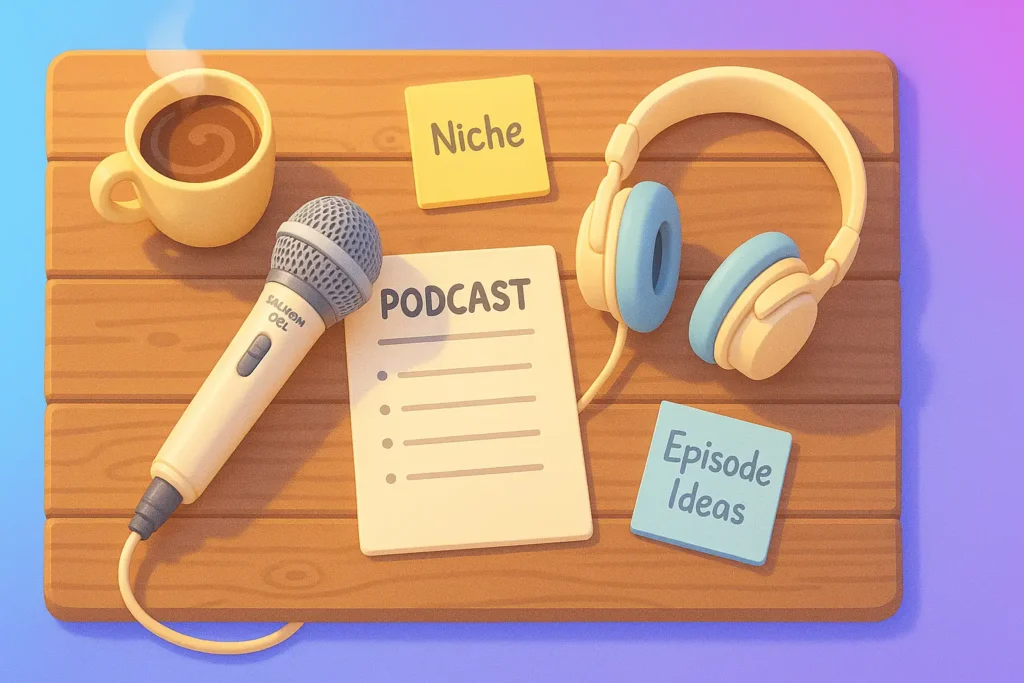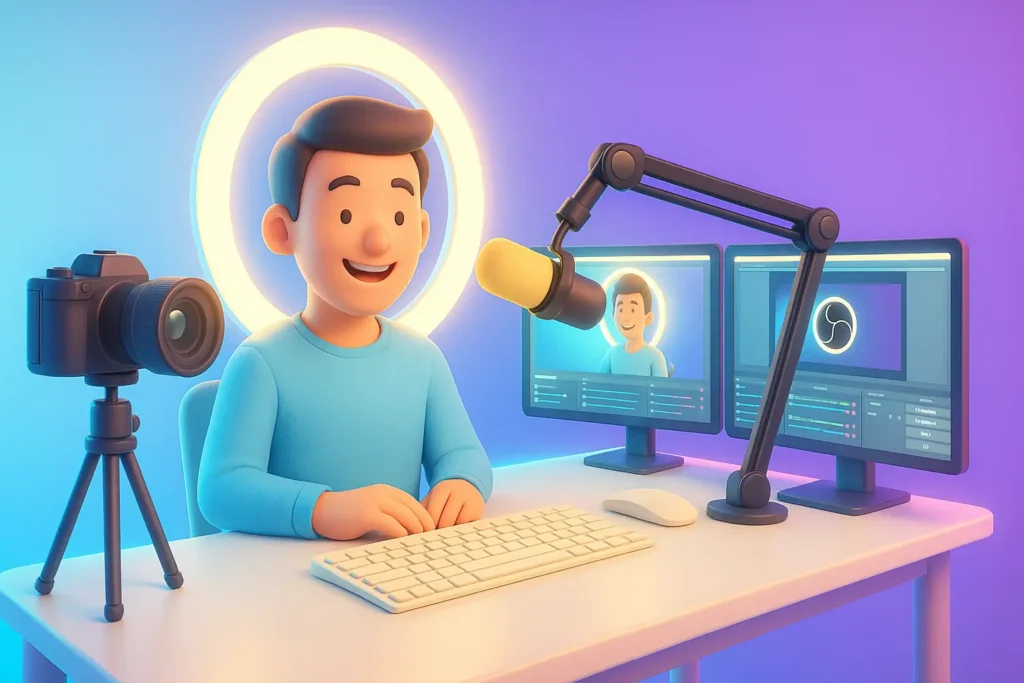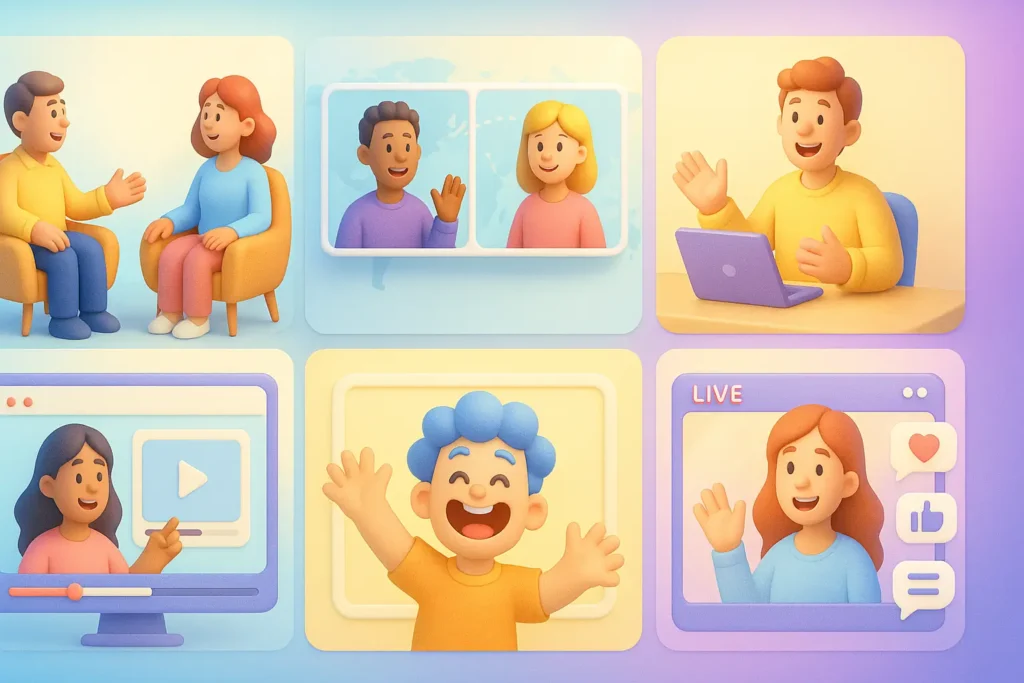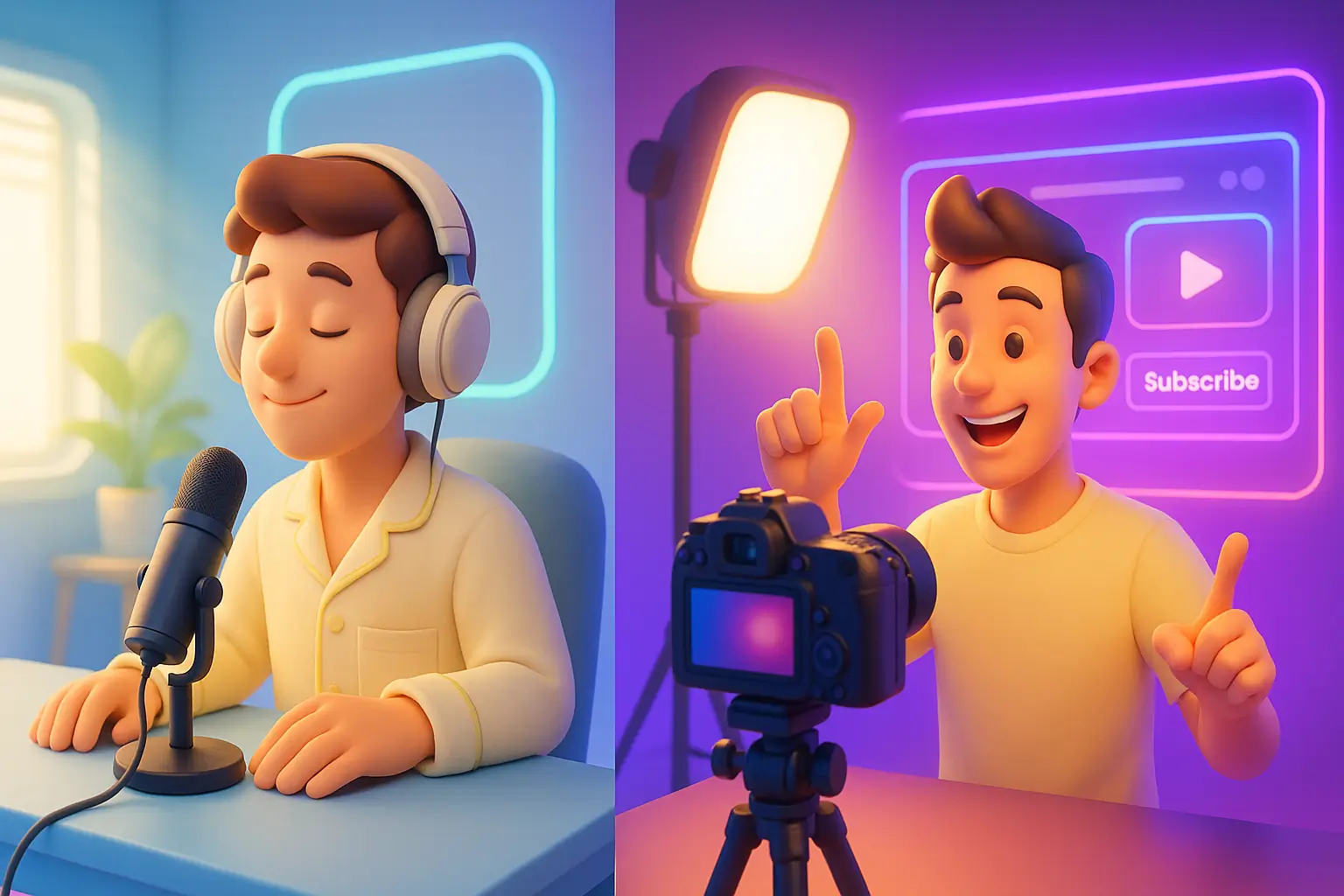Podcasting is booming. Roughly 450 million people pressed play on a podcast in 2023, and analysts expect that number to rocket past 619 million by 2026.
That surge means two things for you: the world clearly loves on-demand audio, and there has never been a better time to learn how to start a podcast.
In this guide, we’ll cover everything you need to go from idea to full-blown podcast production.
Key Takeaways
- Know your niche and purpose. This will keep your content focused and help attract the right audience.
- Audio is simple, video is powerful. A microphone plus quiet room is enough to launch.
- Quit chasing perfect gear. The best microphone is the one you’ll actually switch on. Upgrade later.
- Amazing tools can be free. A good deal of software cover recording and basic edits without costing a cent.
- Consistency wins. A sloppy weekly show outperforms a flawless upload that drifts into hiatus.
Video vs Audio Podcast: Which Route Fits You?
Picture two hosts with identical content. Host A sticks to classic audio, while Host B flips on the camera. Host A enjoys a lighter editing load, cheaper gear, and an audience that can listen while commuting or cleaning.
Host B, meanwhile, lands in YouTube recommendations, slices eye-catching clips for TikTok, and earns ad revenue from both an audio sponsor and a mid-roll video ad. Does that make video automatically the superior path? Not necessarily.
Audio-only shines when you…
- need to set up quickly with minimal investment;
- have guests who are shy about appearing on-camera;
- want listeners focused solely on narrative, education, or meditation;
- prefer agile scheduling, record in pajamas at 2 a.m. and nobody knows.
A video podcast shines when you…
- crave face-to-face chemistry or body-language cues;
- intend to repurpose material for Shorts, Reels, or LinkedIn teasers;
- hope to make money through YouTube Partner ads, live-stream super-chats, brand integrations, or Patreon tiers that promise behind-the-scenes footage;
- love visual aids, demos, screen shares, or physical products held up to the lens.
For many beginners, hybridizing is the sweet spot: capture clean audio first, film when the topic demands extra punch, and publish both formats. That way, you grab idle commuters on Spotify and casual scrollers on YouTube without doubling your workload.
Using reliable TV broadcasting software can help you manage live streams, switch between scenes seamlessly, and deliver professional-quality content to your audience.
How to Get Ready to Start a Podcast

Here are some steps you have to take if you’re thinking of starting a podcast.
1. Carve out a niche that excites you. A vague promise like “We’ll chat about tech” sounds generic. Specificity helps you stand out and keeps brainstorming sessions productive.
2. Draft at least ten episode ideas. If you struggle to list ten juicy titles right now, your theme might be too narrow, or your passion might fizzle after the honeymoon phase. A solid list signals depth.
3. Don’t script word-for-word. Bullet points and an AI chat, an online tool for ideas, content, or advice, help prevent rambling and keep your points clear. It’s the difference between a smooth episode and one that spirals into a rant about your personal issues.
4. Set up a forgiving recording space. Soft furnishings, wall hangings, even a closet full of clothes tame reverb. Turn off loud fans and silence phone notifications.
5. Gear up:
- USB mic (Samson Q2U or ATR2100 are solid for beginners)
- Wired headphones (to monitor audio and avoid echo)
- If doing video: a camera (your phone works to start), tripod, lighting
6. Design a recognizable brand. Canva’s free templates let you create podcast cover art that still pops at 55×55 pixels. Use one striking image and bold text; complex collages blur into mush on tiny screens. A logo generator can also help create a consistent and memorable brand mark to use across your podcast and other marketing materials.
7. Lock in a hosting platform. Buzzsprout, Anchor, and RedCircle all let you launch an RSS feed at no cost. Look for embeddable players, automatic pushes to Spotify and Apple, and listener analytics that reveal which episodes keep people hooked.
Video Podcast Software and Equipment

If you’re going the video route, let’s talk gear. You don’t need a studio, but you do need a plan.
Camera: As we’ve said, your phone can work (especially modern ones), but a DSLR or mirrorless camera will boost quality fast. Webcam? Acceptable, but not impressive.
Microphone: Still the best choice. People will tolerate mediocre video, but not bad sound. Dynamic mics are podcast staples.
Lighting: A $30 ring light can do wonders. Aim for soft, front-facing light. Shadows on your face? Not flattering.
Accessories:
- Tripod or phone stand
- Boom arm for the mic
- Pop filter
- Acoustic foam or blankets to soften echoes
Software:
- OBS Studio (free, great for capturing camera + screen) or Audacity (for recording audio)
- Riverside.fm or Zencastr (for remote interviews)
- Vegas Pro, DaVinci Resolve, or even something like OpenShot for editing. Mac users can use iMovie, but if you haven’t got one, you’ll quickly realize there’s no iMovie for Windows, though alternatives exist.
Six Proven Formats for Your First Video Podcast

Video podcasts aren’t one-size-fits-all. Here are some ideas you can use:
- In-person interview. Two mics, comfy chairs, maybe a plant between you. Physical presence boosts energy and fosters storytelling that audio-only can’t replicate.
- Remote conversation. Split-screen chats let you invite global experts without airfare. Stable internet connection plus local backups keep audio crisp.
- Solo monologue. Ideal for thought leaders teaching niche skills or sharing weekly reflections. Authenticity carries the show, so speak as if you’re on a call with one listener.
- B-roll hybrid. Overlay screen captures, slide decks, or product demos to illustrate points. AI for Google Slides can help create these visuals quickly and professionally. Great for tutorials about coding, cooking, or gear reviews.
- Animated storytelling. Apps like Vyond turn voiceover into motion graphics, perfect when you’d rather stay off-camera or need visual metaphors.
- Live reaction. Stream a keynote, sports draft, or trending meme and comment in real time.
And remember: switching styles occasionally can keep loyal audiences curious and attract new viewers looking for fresh vibes.
How to Make a Podcast Episode
- Pick a laser-focused topic every week. “Fitness” covers the planet; “How kettlebell swings help desk workers fight back pain” promises immediate value.
- Research like a journalist. Stats, anecdotes, and counterpoints all boost credibility and ward off fluff.
- Craft a listener-first structure. Start with a 30-second hook, outline three takeaways, weave stories among facts, and close with a clear call to action.
- Warm up and record. A few tongue twisters, controlled breaths, and posture checks prevent vocal fatigue. Verify gain levels, so peaks don’t distort, then press record and let natural cadence flow.
- Back up files immediately. Cloud-sync raw tracks or duplicate to an external drive. Accidental deletions haunt anyone who ignores this rule.
- Edit for flow. Tighten pauses, trim tangents, add intro music, and level volumes. For video, splice in B-roll, on-screen text, and chapter markers for easy navigation.
- Export two final masters. One MP3 for RSS and one MP4 (or MOV) for YouTube. Same core content, platform-optimized.
- Publish and distribute. Schedule drops at the same hour every week, so listeners form habits. Feed hits Spotify automatically; video premieres notify YouTube subscribers instantly.
- Promote, reflect, improve. Repurpose the juiciest 30 seconds into Shorts, answer listener emails, and review analytics to learn what segments retain attention. When promoting your podcast via email, make sure to check email address first to ensure they are valid and your messages reach the intended audience. When promoting your podcast via email, make sure to check email addresses first to ensure they are valid and your messages reach the intended audience. Using email platforms like Beehiiv can help automate and track these campaigns efficiently. Consistent iteration is how good shows become great.
Common Pitfalls

- Perfection paralysis. You tinker for weeks and never hit publish. Remedy: set a public launch date and stick to it, done beats perfect.
- Inconsistent scheduling. Random drop times confuse algorithms and humans alike. Batch-record and schedule episodes in advance, so life emergencies don’t break your streak.
- Ignoring audio hygiene. Chair squeaks, barking dogs, and mic pops scream amateur. Invest in a pop filter and calmly re-take noisy lines rather than “fix it in post.”
- Over-editing personality. Remove distracting parts, but leave natural quirks.
Conclusion
The key to podcasting is simple: you just need to start. Define your message, get decent gear, and publish consistently. Don’t overthink every detail, just launch. Your podcast will evolve. Your skills will sharpen. And with a bit of luck and a lot of effort, you just might make money doing what you love.
FAQs
1. Do I need to appear on camera to start a podcast?
Nope. Many successful podcasts are audio-only. If you’re camera-shy or want to keep production simple, stick to sound.
2. How long should a podcast episode be?
There’s no single magic length; it depends on your topic and audience. Many shows thrive with 20–30-minute episodes, while others stretch past an hour.
3. How do I grow my podcast audience?
Publish on a regular schedule, optimize titles and descriptions, and repurpose clips on platforms like TikTok or Instagram. And don’t forget to engage with your listeners.
4. Can I make money from podcasting?
Absolutely! But it usually takes time. Monetization options include sponsorships, affiliate marketing, YouTube ads (for video), premium content on Patreon, or even selling your own products.



